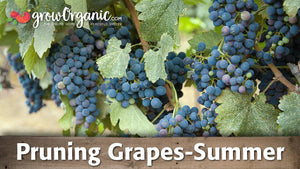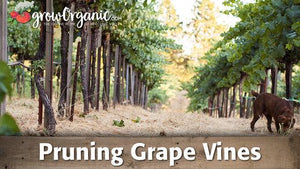Item Number: FV050
Wine Grape Vine - Zinfandel
Bold flavors, endless wine possibilities.
Mix-and-match for free shipping when purchasing 6 or more perennial berries, vines, or crowns!
Zinfandel, a celebrated red grape variety, offers bold, complex flavors and versatile wine-making potential. Originating in Europe and now a cornerstone of California vineyards, Zinfandel vines produce tight clusters of fruit that adapt beautifully to various climates, delivering high yields and exceptional quality. From bright red berry notes in cooler areas to deep blackberry, anise, and pepper flavors in warmer regions, Zinfandel is a must-have for home winemakers and seasoned vintners alike.
Bare Root Vine
- Variety: European
- Zones: 6-10
- Harvest: August
- Pruning: Cane or Spur Prune
- Flavor Notes: Red berry fruits like raspberry in cooler climates, with blackberry, anise, and pepper notes in warmer regions.
Key Highlights
- Zinfandel is genetically identical to Primitivo, known for its intensely fruity wines with a luscious texture.
- Versatile in wine styles, Zinfandel produces light-bodied reds, full-bodied dry wines, and sweet late-harvest options.
- Thrives in full sun with well-draining soil and benefits from proper pruning to optimize airflow and reduce disease risk.
- Tightly packed clusters must be harvested promptly to avoid bunch rot.
Cultivation Tips
- Site Selection: Plant in a sunny location with 6–8 hours of direct sunlight. Loamy, well-draining soil ensures healthy growth.
- Pruning: Prune during dormancy to maintain vine health. Use cane pruning for controlled fruit production or spur pruning to manage vigorous growth in warmer climates.
- Watering: Provide deep watering during growth years and reduce as the fruit ripens to enhance sugar concentration.
- Fertilization: Feed with a balanced fertilizer in early spring or enrich soil naturally with organic compost.
Wine Potential
Zinfandel grapes are the foundation for a variety of wine styles, from light and fruity to rich and robust. Their natural sugar content supports creating everything from vibrant reds to sweet late-harvest wines.
Add Zinfandel vines to your vineyard for a rewarding experience that delivers bold flavors and unmatched versatility. Whether for fresh table grapes or crafting your signature wine, this vine is a timeless classic for wine enthusiasts.
Visit our Berry, Vine & Crowns Characteristics Chart to compare growing characteristics for all our berries, vines, and crowns.



Check Your Zone Compatibility:
Compatible with your zone.
Growing Zone for

Our Guarantee To You
Since 1976, we've served our customers at every stage of growing. Please contact us at any time. We are happy to support and assist you.
Shipping Information
Shipping Information
Cannot ship to the following states: HI , AK , PR , GU , VI , OR , WA , ID
Cannot ship via USPS.
Cannot ship via SmartPost.
Shipping Weight: 3.3 lb
Dimensions: 26.0"L x 3.0"W x 3.0"H
Features
Features
- Open-Pollinated
- Thornless
Characteristics
Characteristics
Planting & Care
Planting & Care
Useful Information
Useful Information
Guarantee
Guarantee
Limited Dormant Tree & Plant Guarantee
* Claim deadline is June 15th
We guarantee that your dormant tree or plant will arrive in good, viable condition. If your tree arrives in substandard condition, notify us within 3 days of delivery. Please email pictures of the box, inside packaging, the tree and its roots to helpdesk@groworganic.com. We will investigate your claim and process a request to exchange or refund the damaged product.
If your dormant tree or plant has not grown new leaves by June 15th, you may be eligible for our Limited Dormant Tree & Plant Guarantee. This guarantee provides for a store credit for the purchase price of the tree, excluding shipping. Please see the Instructions below.
Important Dates:
- April 1st Dormant trees/plants must be planted in the ground
- May 15th Perform scratch test, if no new leaves have grown
- June 15th Deadline to apply for a dormant tree/plant credit
All required documentation must be received by June 15th for your claim to be considered. Claims or documentation received after June 15th will be denied, without exception. Instructions listed below
Terms and Conditions
We cannot guarantee that your tree or plant will remain alive and healthy after it is received, or bear fruit as there are too many variables in your environment that are beyond our control (i.e. soil preparation, weed and pest control, proper irrigation, chill hours, compatible hardiness for your growing zone, proper choice of pollinator, extreme weather, rodent damage, disease, etc.).
We cannot guarantee that we will be able to provide a replacement tree/plant of the same species either that same growing season or in future years. Customers are responsible for all shipping fees associated with replacement trees and plants.
If we determine that the tree you purchased directly from us is not viable, we will issue you a store credit (not a refund) for the purchase price of the affected dormant tree or plant. Shipping is not included in the dormant tree/plant guarantee. Store credits can be used to purchase any product we sell and are valid for use only until July 1st of the following year.
Historically, 98% of our dormant trees and plants grow and thrive when they have been cared for and planted using our growing guides. Dormant trees and plants must be planted in the ground by April 1st in order to be eligible for credit. If the ground in your area is still frozen solid, you may temporarily plant your tree or plant in a pot.
Potted, non-dormant trees or plants are excluded from this guarantee as they are not dormant at the time of shipment. Evergreen trees such as citrus, avocado and olive trees are not available for credit under the Dormant Tree and Plant Guarantee.
Instructions
We guarantee that your dormant fruit tree or plant will leaf out, if you care for it according to our growing guides. In the unlikely event that your dormant tree or plant does not have leaves by May 15th, follow these simple steps to apply for a store credit:
Before you call or email, please perform a “scratch test” to determine if the tree or plant is still alive. This video shows how to check for live tissue under the bark. Scratch tests need to be done a few inches above and below the graft.
Green Cambium Layer / Living Trees
If the cambium layer under the bark is green, give your tree a little more time. It is still alive, but hasn’t come out of dormancy yet. Check to make sure that it is getting the right amount of deep root water, enough sunlight and that the weather is warm enough for that type of tree/plant to come out of dormancy. Every tree has its own personality and will come out of dormancy at different times. Be sure to submit the required documentation listed below by June 15th, if it doesn’t grow leaves.
Brown Cambium Layer / Dead Trees
If the scratch test shows a brown cambium layer or if your dormant tree/plant doesn’t have leaves by June 1st, please email us at helpdesk@groworganic.com. All required documentation listed below must be received by June 15th for your claim to be considered. To be considered for the guarantee claim, all required documentation must be received by June 15th. Incomplete submissions will be denied.
Required Documentation
- Order number
- Name of dormant tree/plant and the quantity affected
- Photos of each tree or plant showing:
- The roots (tree or plant must be pulled out of the ground)
- The scratch test areas
- The entire tree/plant
We reserve the right to not issue credit for items that have already been replaced. We also reserve the right to require photographic evidence that the tree/plant was not killed by root rot, rodent or mechanical damage.
Share

I always get good plants from Peaceful Valley. I have been ordering for almost 20 years. The stems branch well and should produce many vines in the Spring.
Videos
Articles
-
 Sun, Jan 07, 2024
Sun, Jan 07, 2024Planting & Growing Grapes
-
 Wed, Mar 12, 2025
Wed, Mar 12, 2025When to Plant Grapes: A Complete Guide to Planting Grapes in Clay Soil and Beyond
-
 Thu, Jul 03, 2025
Thu, Jul 03, 2025Trim Grapes in Summer With Confidence: Learn How to Trim Grape Vines in Summer and the Secrets to Pruning Grape Vines During Growing Season
-
 Thu, Feb 06, 2025
Thu, Feb 06, 2025Planting & Pruning Grape Vines









